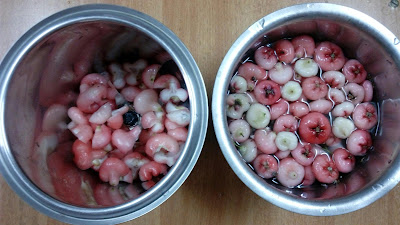Inspired by Mathi's Kitchen
Cabbage (chopped) - 1 cup
Mushroom (cleaned and chopped) - 1 cup
Maida - 1 cup
Corn flour - 1/4 cup
Kashmiri Red Chilli Powder - 1 tsp
Garam Masala - 1 1/2 tsp
Salt - As required
For the Masala:
Oil - 2 tbsp or as required
Onion - 1 big (finely chopped)
Ginger Garlic Paste - 1/2 tbsp
Green Chilli - 1
Curry leaves - few
Turmeric Powder - 1/4 tsp
Garam Masala - 1/2 tsp
Salt - As Required
Chilli Powder - 1/2 tsp
Tomato sauce - 2 1/2 tbsp
Soya Sauce (optional) - 2 drops
Chilli Sauce (optional) - 1/2 tsp
Method:
1. Rinse the cabbage well, drain the water and take it in a bowl.
2. Also, clean the mushroom and chop finely.
3. Now add the mushroom to the cabbage. Also, add maida, cornflour, chilli powder, garam masala, and salt.
4. Mix well to make a dough without adding any water.
5. Deep fry these as you make the regular pakoras.
6. Keep aside to cool down.
To make the masala:
1. Add oil in a kadai.
2. Once hot, add in finely chopped onions, curry leaves and ginger garlic paste. Saute until the raw smell goes off.
3. Now add chilli powder, garam masala, turmeric powder and salt. Saute on low flame for a minute.
4. Meanwhile, make a mixture of 1 cup water and 1 tbsp corn flour without any lumps.
5. Now add this mixture and cook on medium flame.
6.Once it attains gravy stage, add tomato sauce, soya sauce and chilli sauce.
7. Add in the pakoras cut into small pieces.
8. Kaalan is ready. Garnish with finely chopped onions and coriander. Squeeze lime if desired.
Note: Due to lockdown, mushroom wasn't available. So we used 2 cups of cabbage. Also, we used a little water to bind the pakora dough.





















